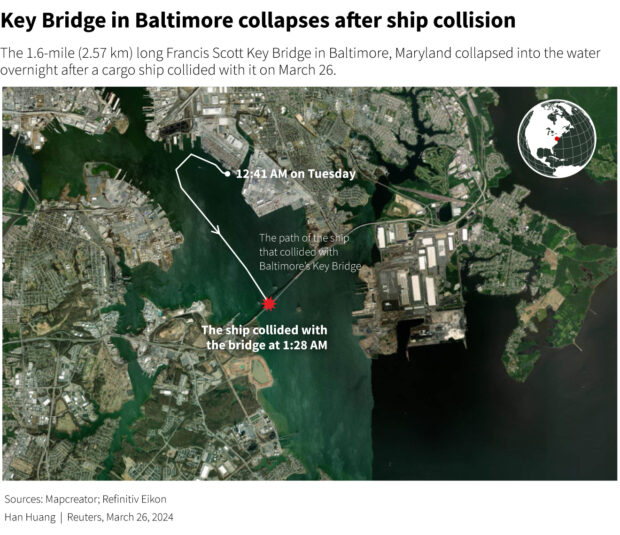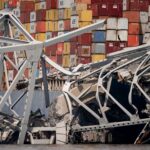Baltimore’s Francis Scott Key Bridge collapsed early on Tuesday after a container ship smashed into a pylon, sending eight people into frigid water below.
A container ship named the Dali was sailing down the Patapsco River when it struck a pylon of the bridge in the early morning hours, crumpling almost the entire structure into the water.
A construction crew was fixing potholes on the bridge and eight people fell into the river where water temperatures were 47 F (8 C).
Two people were rescued, one unharmed and one critically injured. Six people remain missing.
The vessel’s crew notified authorities of a power issue before the crash, Maryland Governor Wes Moore said.
The bridge was up to code and there were no known structural issues, he said.
There was no indication of terrorism, police said.
The Dali was leaving Baltimore en route to Colombo, Sri Lanka.
All 22 crew, including two pilots on board, have been accounted for and there were no injuries, the ship’s manager, Synergy Marine Group said.
The registered owner of the Singapore-flagged ship is Grace Ocean Pte Ltd, LSEG data show.
The ship is 948 feet (289 meters) long and can hold up to 10,000 twenty-foot equivalent unit, or TEU, a measure of cargo capacity.
It was stacked high with containers, carrying 4,679 TEU.
The Francis Scott Key Bridge, a four lane bridge that sits 185 feet (56 meters) above the river, was one of three ways to cross the Baltimore Harbor and handled 31,000 cars per day or 11.3 million vehicles a year.
It opened in 1977 and crosses the Patapsco River, where U.S. national anthem author Francis Scott Key wrote the “Star Spangled Banner” in 1814 after witnessing the British defeat at the Battle of Baltimore and the British bombing of Fort McHenry.
Traffic was suspended at the port after the collision.
It is one of the smallest container ports on the Northeastern seaboard, handling about a tenth of the volume that passes through the Port of New York and New Jersey.
The flow of containers to Baltimore can likely be redistributed to bigger ports, said container shipping expert Lars Jensen. However, there could be major disruptions in shipping cars, coal and sugar.
It is the busiest U.S. port for car shipments, handling at least 750,000 vehicles in 2023, according to data from the Maryland Port Administration.
In 2023, the port was the second busiest for coal exports.
It is also the largest U.S. port by volume for handling farm and construction machinery, as well as agricultural products such as sugar and salt.
(Writing by Lisa Shumaker; Editing by Daniel Wallis)





















 Survey Offers Tips on Ways to Assist Homeowners in Procuring Adequate Coverage
Survey Offers Tips on Ways to Assist Homeowners in Procuring Adequate Coverage  Berkshire Wary of “Fashionable’ Cyber Insurance, AI
Berkshire Wary of “Fashionable’ Cyber Insurance, AI  AM Best: Social Inflation Key Factor in Rise of Loss Severity
AM Best: Social Inflation Key Factor in Rise of Loss Severity  Jain Successor Is Recurring Berkshire Board Topic; Leadership Lessons
Jain Successor Is Recurring Berkshire Board Topic; Leadership Lessons 
